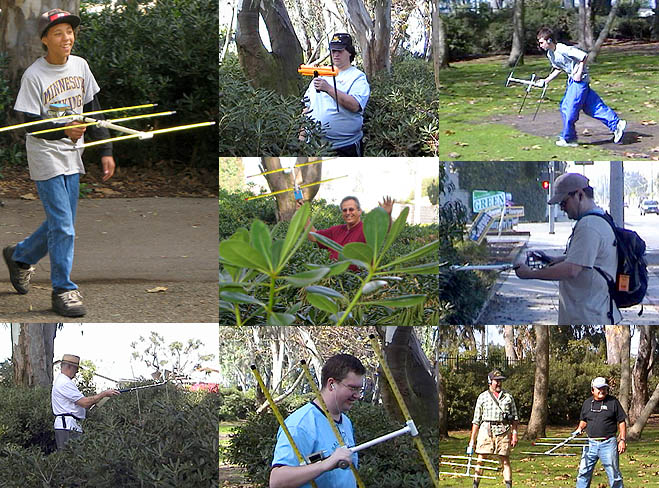

Huntington Central Park ARDF on 11/4/06
Report below by Joe Moell KØOV. Photos above by Joe and April Moell.
 It's always risky to plan a hidden transmitter hunt for November in southern California, with the possibility of Santa Ana winds or even a rainstorm. But November 4 was a near-perfect day for our event in Huntington Central Park. Other activities kept the usual group from Santa Barbara away, but that was more than compensated for by a large turnout from the San Diego area.
It's always risky to plan a hidden transmitter hunt for November in southern California, with the possibility of Santa Ana winds or even a rainstorm. But November 4 was a near-perfect day for our event in Huntington Central Park. Other activities kept the usual group from Santa Barbara away, but that was more than compensated for by a large turnout from the San Diego area.
This park has none of the perils of the wilderness, such as poison oak, snakes, and mountain lions. However, the brush that concealed most of my transmitters also had spiders of every size with plenty of large webs. Look before you punch!
I designed the five-fox two-meter ARDF course just for beginners and inexperienced foxhunters. It was only 3.4 kilometers in length, but there were some deceptive signal reflections from hills and buildings, especially on the transmitter near the lake shore.
Everyone went for the full course immediately, except for 13-year-old Marcus Smith (upper left in the photo) and his Dad. They got some basic training first on my three practice transmitters, and then they were ready for their first time on an international-rules course.
Name and call Foxes Time
Jay Thompson W6JAY 5 1:36:12
Bill Elkerton W6ZM 5 1:38:45
with Robin Elkerton KC6LEA, Bryan Elkerton KI6DUR and Richard Sherwood KF6UVE
Joe Loughlin KE6PHB 5 2:15:25
with Tony Boegeman WA6ZMZ
Marcus Smith 5 3:03:28
with Mark Smith KG6ZOY and Aaron Bentley KA6MKU
Joe Corones N6SZO 4 3:55:16
with Cliff Steagall KG6VAJ
John Frerichs N6VCW 1 1:19:40
with John Hill K6JCH and Michelle Streeter
Unfortunately, the hunters were so worn out after their two-meter experience that I couldn't convince them to try to find the 80-meter transmitter. Perhaps I'll recycle that hiding spot next year.
Thanks to everyone who came out. Also thanks, as always, to April WA6OPS for keeping time as well as for bringing those tasty miniature pecan pies and carrot cakes.
Joe Moell KØOV
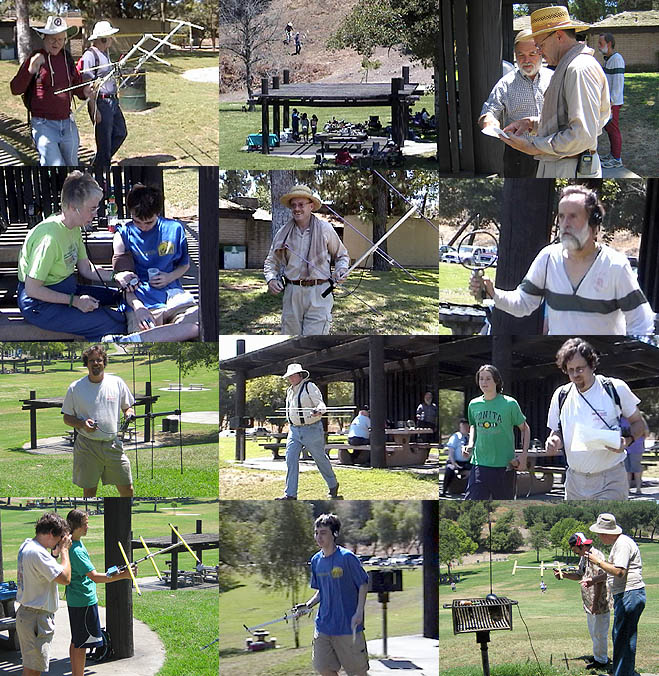
Bonelli Park ARDF on 7/15/06
Report below by Joe Moell KØOV. Photos above by Joe and April Moell.
"It will be the hottest day of the year so far." That was the Los Angeles county forecast as we put out transmitters for ARDF at Bonelli Park. But it was a good day. The thermometer rose to 94, then backed down a bit and stayed at 92 for most of the morning and early afternoon. Most of the transmitters had been found and picked up by mid-afternoon when the temperature moved into the high 90s.
Almost everyone ignored my beginner 2m transmitters and immediately took on the main 2m course, set by Marvin Johnston KE6HTS. He placed the foxes where climb would be minimal but there were still some interesting route choices.
According to Marvin, "Bonelli is a really nice location for intermediate ARDF practice with well-mapped features and relatively flat terrain. The total course was about 4 km. The start corridor was aimed at fox #1, and the placement was such that it should have been found in the 6th minute. From #1, there were three reasonable routes, 3-2-4-5-F, 5-4-2-3-F, or 5-3-2-4-F. For an individual, that choice would depend on where the bearings and field strength put the other controls. As can be seen on the map below, #4 was a dogleg and that happened only because the location of #2 was changed to reduce the climb. (It was to go about 600 meters NNW from #4.)"
Both ARDF Team USA members did the full course in good time. Some hunters minimized time in the sun by returning before locating all the foxes. Randy Lafferty W6RAL and his son Drew KG6OEP, who live close by, came out to take photos and learn about ARDF for a presentation Randy will make at the ham club where he works. They took to the course for a while and discovered that their RDF antenna needed some improvements.
Name and call Foxes Time
Bob Cooley KF6VSE 5 0:55:54
Jay Thompson W6JAY 5 1:27:47
Scott Moore KF6IKO 5 1:46:55
Ken Erickson KG6TES 5 3:45:24
with Jim Ford N6JF
Roman Kamienski KG6QMZ 4 3:35:10
Dmitri Gropen 3 1:01:28
Bill Smathers KG6HXX 2 1:37:13
I found a nice cool spot for the 80m transmitter, nestled in trees by the stream for good ground conductivity. What I didn't notice was that it was quite close to an overhead high voltage power line that connects to another HV line passing within 150 feet of the start/finish area. Re-radiation from the line caused no problems for some hunters, but it might explain why one couldn't get good enough bearings to find this fox.
Name and call Time
Dmitri Gropen 10:50
Bob Cooley KF6VSE 15:37
Ken Erickson KG6TES 37:40
with Jim Ford N6JF
As usual, thanks to Marvin for a fine 2m ARDF course and to April for timing and medical duties.
Joe Moell KØOV
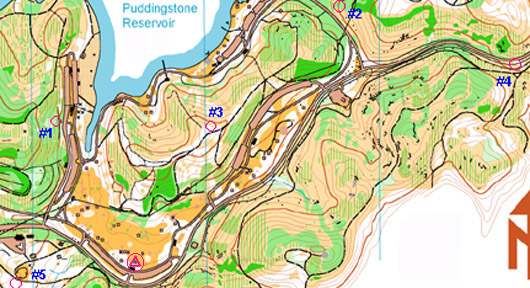
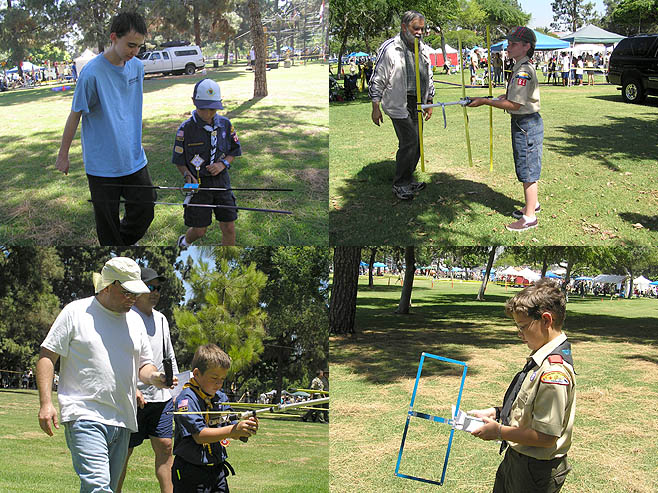
Heartwell Park Scout RDF on 6/3/06
Report below and photos above by Joe Moell KØOV
For the fourth year, Scouts of all ages had the opportunity to try transmitter hunting at no charge during the Long Beach Scout-O-Rama in Heartwell Park on June 3. RDF was part of a comprehensive Amateur Radio display set up by Associated Radio Amateurs of Long Beach (ARALB) and Orange County Hospital Disaster Support Communications System (HDSCS). There were six standalone hidden transmitterson the 2-meter band plus five pulsed 218 MHz wildlife tag transmitters. There was also a simple 3-fox course on the 2m band.
Teaching RDF to the Scouts were (in alphabetical order) Tom Gaccione WB2LRH, Marvin Johnston KE6HTS, Joe Moell KØOV, Jay Thompson W6JAY and Richard Thompson WA6NOL. Nobody kept track of the number of Scouts who tried RDF, but all of the teaching hams were kept very busy helping groups of two or three at a time.
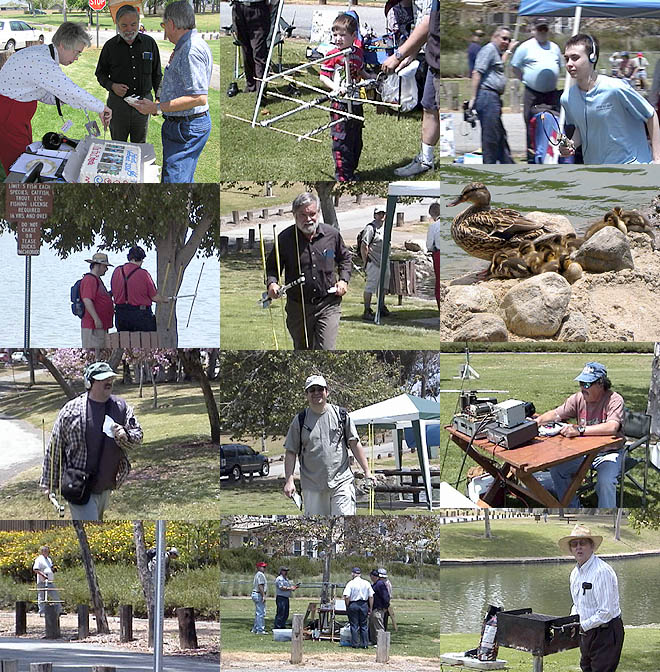
Tri-City Park ARDF on 5/13/06
Report below by Joe Moell KØOV. Photos above by Joe and April Moell.
On-foot hidden transmitter hunting was clearly the most popular activity at this year's Antennas In The Park (AITP), an outdoor ham radio day sponsored by the Fullerton Radio Club. As one group tested a monster 15-meter beam on a portable crank-up tower, others set out to find nine radio foxes.
It was good to see newcomers learning to do radio direction finding with help from those with more experience. There were just three "practice" transmitters, all within 100 yards of the AITP picnic area. Here is how they did:
Name and call Foxes Time
Paul Grable 3 0:25:10
with Richard Clark N6UZS
Garrick Wood (age 5) 3 0:29:23
with his dad Travis AE6GA
Daniel Welch KG6WAP (age 9) 3 1:11:36
with his parents Mike KG6FWH and Cindy KG6HLN
Aaron Bentley KA6MKU 3 1:27:24
The practice foxes were enough for the two pre-teens, but others gave the ARDF course a try. It was a chance to experience international-rules hunting with five transmitters on one frequency, each on the air for one minute at a time in sequence. The entire hunt area was just 60 acres, so a direct route on the course was less than 1.5 kilometers. But there were some surprises to it, including some strange "waveguide effect" bearings from fox #5. Nevertheless, for 20-year-old Jay Thompson W6JAY it was just a sprint.
Name and call Foxes Time
Jay Thompson W6JAY 5 0:36:03
Marvin Johnston KE6HTS 5 0:55:12
Bill Smathers KG6HXX 5 0:58:22
Paul Grable 3 1:55:10
with Richard Clark N6UZS
The 80-meter transmitter was in the tall tree area of the park. Two hunters made short work of it. Also when Dick Dabney W5UFZ had trouble with his two-meter RDF setup, he pulled out his 80-meter set and found that one, untimed.
Name and call Time
Jay Thompson W6JAY 6:37
Bill Smathers KG6HXX 8:13
AITP would not be complete without the annual National Foxhunting Weekend cake, courtesy of April Moell WA6OPS, who is also our official fox wrangler and field medic. This year's special dessert (photo below) featured frosting-jet printed photos of competitors at the 2006 USA ARDF Championships in North Carolina.
Many thanks to President Paul Broden K6MHD and other leaders of the Fullerton Radio Club for making all the arrangements that resulted in a day of fun at Tri-City Park. Thanks to all who came out, and see you next time!
Joe Moell KØOV
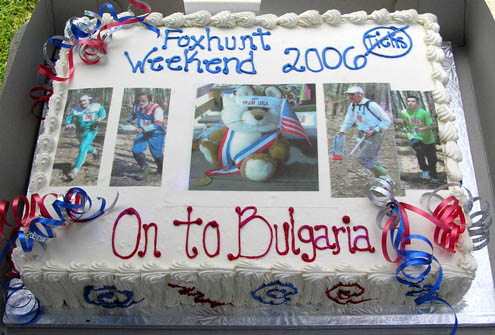
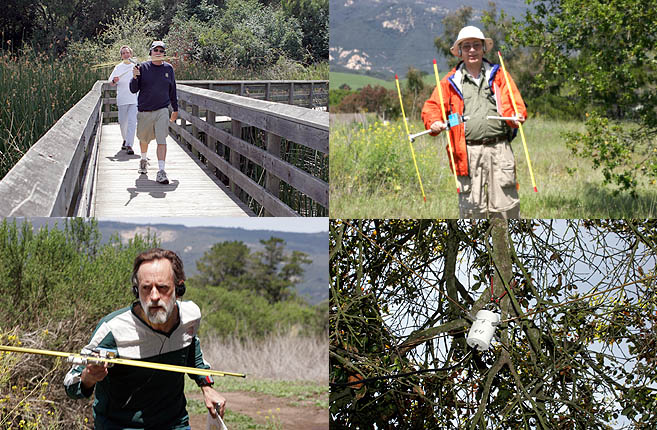
Lake Los Carneros ARDF on 4/1/06
Report below by Marvin Johnston KE6HTS. Photos above by Eve Vigil KF6NEV.
Lake Los Carnaros in Goleta on April 1 was the location of the latest ARDF practice, the last one for Southern Califonia before the US ARDF Championships in North Carolina. In addition to the ARDF course, I laid out a Yellow orienteering course for some Girl Scouts who were working on getting credit for this activity . That was fun, and they all enjoyed the event. We offered equipment for them to try ARDF, but they were a bit too tired and hungry, so that might happen next time.
We had nine people show up for the hunt including Bob Cooley (US and International Gold medal winner) from up near San Francisco, and Sam and Eve Vigil from San Luis Obispo. Newcomers to ARDF were Jim and Shirley Sheppard. Winnie Hennigan KA6OFZ also went out on the course. Times for the Sheppards and Winnie were not recorded.
Total course length was 2.4 kilometers. I laid it out that the optimum order was start-1-4-2-3-5-finish, and that is the order most people took. Because of the small venue size, the normal spread between transmitters was reduced to about 200 meters. Unfortunately, I started WB6RDV on transmitter #5 instead of transmitter #1 like everyone else. Instead of taking transmitter #1 first as the course was designed, he headed towards transmitter #5, and this resulted in a probable slower time for the course.
E-punch was not used on this course.
Name and call Foxes Time
Bob Cooley KF6VSE 5 0:28:09
Jay Hennigan WB6RDV 5 0:34:00
Scott Moore KF6IKO 5 0:54:28
Bill Smathers KG6HXX 5 0:55:25
Sam Vigil 5 1:28:07
with Eve Vigil KF6NEV
Marvin Johnston KE6HTS
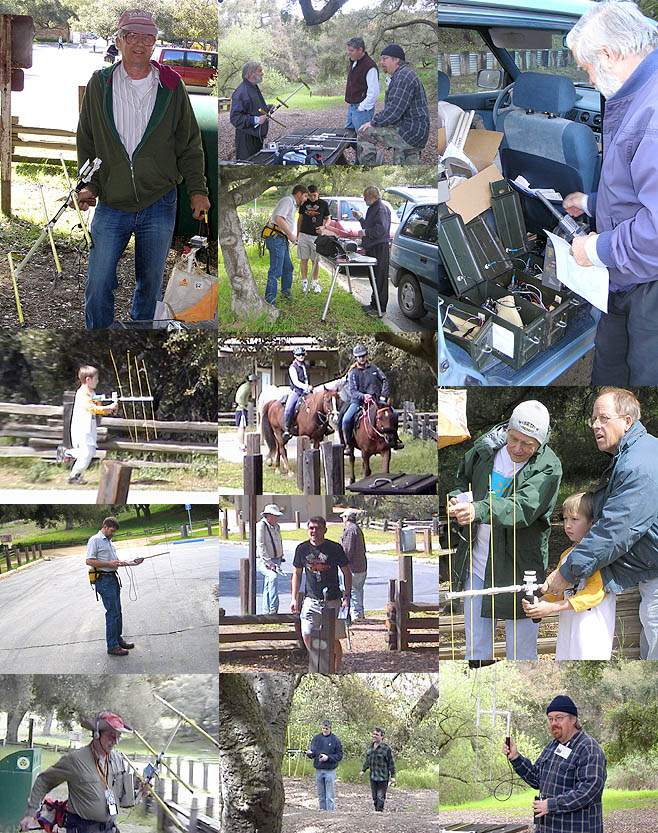
Topanga Park ARDF on 3/18/06
Report below by Joe Moell KØOV. Photos above by Joe and April Moell.
Cold rain fell the night before and the evening after, but partly cloudy skies prevailed throughout the day for our first-ever ARDF session at Topanga State Park. The air was fresh and clean at 1200 feet in the Santa Monica Mountains. Except for wet grass and a little mud on the trails, the running and walking conditions were perfect.
Most of the regular California radio-orienteers who would be competing at the USA ARDF Championships came out for a practice run. Bob Cooley KF6VSE was headed down Interstate 5 from his home in Pleasanton but had to turn back when he heard that the "Grapevine" mountain pass was closed due to snow and ice.
LAOC has mapped only about 335 acres of the park, so the advanced course could only be about 3 kilometers long. That made for faster-than-normal times, as follows.
Name and call Foxes Time
Jay Hennigan WB6RDV 5 0:49:04
Scott Moore KF6IKO 5 1:06:46
Matthew Dods KG6PPB 5 1:07:55
Bill Smathers KG6HXX 5 1:17:23
Dean Dods KD6I 5 1:20:49
Dick Norton N6AA 5 1:48:14
Terry Newman AE6JR 4 2:54:08
Sam Vigil WA6NGH 3 2:00:27
Thanks to some extra publicity aimed toward the Topanga Canyon area hams by Dick Norton N6AA (ARRL SW Division Director) and Rob Hanson W6RH (Conejo Valley ARC), several of them came out and tried transmitter hunting for the first time. Equipment was limited, so they combined into groups of two or three and learned from one another. Terry Newman AE6JR, who is rapidly becoming an expert, found two of the beginner transmitters quickly and then set out on the advanced course, where he found all but one. Beginner results:
Name and call Foxes Time
Lynn O'Connell KG6DNY 5 1:58:53
Bryne Anderson KF6IKI 4 2:07:05
with Bob Loftos KG6UUV and James Grasso K3TDC
Alex Smith (age 8) 3 0:38:30
with Ken Smith KF6MBX
Terry Newman AE6JR 2 0:29:38
The single 80-meter transmitter was 0.6 kilometer away and was taken on by three hunters. Only two of them found it, with times as follows:
Jay Hennigan WB6RDV 11:10
Scott Moore KF6IKO 20:00
After the hunt was over and all the transmitters were retrieved, several of the participants ended up at an Italian restaurant in Fernwood to debrief the hunt and plan future events.
Joe Moell KØOV
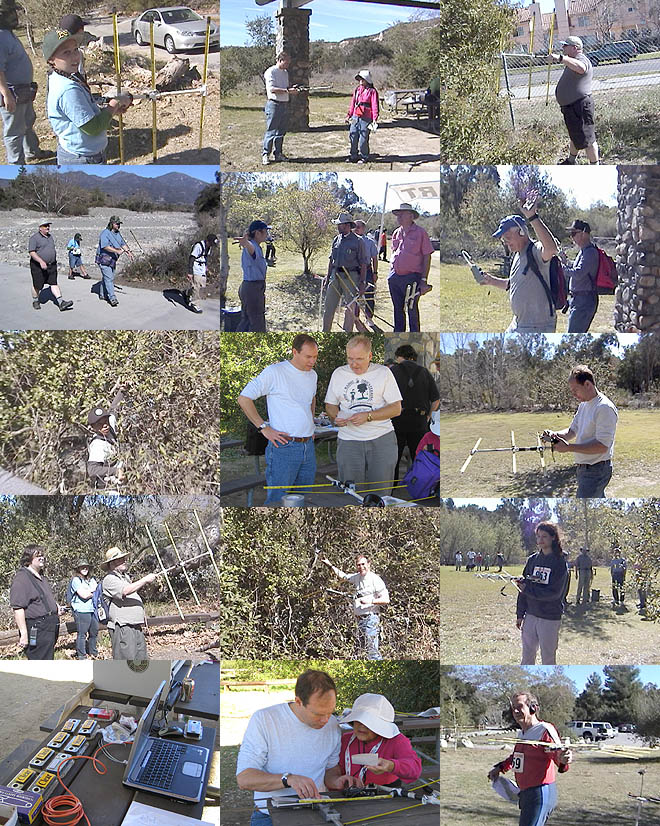
O'Neill Park ARDF on 2/12/06
Report below by Joe Moell KØOV. Photos above by Joe and April Moell.
While eastern parts of the USA were experiencing the Blizzard of '06 with record snow, the temperature at O'Neill Regional Park was in the 80's and sunscreen was being liberally applied. It was a great day for orienteering and radio-orienteering. The advanced course was put on in conjunction with the Valentine Score-O event of Los Angeles Orienteering Club. It was designed to be good practice for those planning to compete in the 2006 USA ARDF Championships in North Carolina. By standard measurements, course length was 7 km and climb was 195 meters. Fourteen persons (9 individuals and 2 groups) took to that course, including some newcomers. There was a 3-hour time limit.
According to course-setter Marvin Johnston KE6HTS, "As you look at an orienteering map with magnetic north up, this park is shaped like a V with the left side of the V a hilly and rugged area, while the right side of the V is mostly flat. The park extends about 1.6 km on the right side with a width of about 500 meters. It is about 2.2 km long on the left side with a width of about 700 meters and a 'bulge' at the top. A road runs along the very right side of the V and is about 50 meters above the flat portion. The flat portion is challenging because there are a lot of reflections from the hill in the middle of the V."
Marvin continues, "Transmitters #4 and #5 were located near the road on the right side of the V about 50 meters higher than the rest of that area, with #5 the farthest. Almost everyone said these were difficult to find because of the reflections. Part of the problem seemed to be that being about 50 meters below the transmitters, the reflections were stronger than the main signal. Jay WB6RDV went to the high ground first and had little problem finding both transmitters. Several people added to the climb by going up to #5, going back down, then climbing again to #4, or vice versa. The left side was the most physically challenging but was fairly straightforward with a road running along the inside of the V most of the way up. Foxes #3 and #4 were 50 to 100 meters from the road, with #2 farthest out."
Here are times for the 5-fox ARDF advanced course. Only persons/groups that found at least one transmitter are listed.
Name and call Foxes Time
Jay Hennigan WB6RDV 5 1:38:28
Bob Cooley KF6VSE 5 2:11:10
Scott Moore KF6IKO 3 2:50:36
Ken Erickson KG6TES 2 2:21:58
with Jim Ford N6JF
Tom Gaccione WB2LRH 1 2:26:11
Bill Smathers KG6HXX 1 2:58:58
Joe Corones N6SZO 2 >3 hrs
with Joe Loughlin KE6PHB and Tony Boegeman WA6ZMZ
Meanwhile, several newcomers were learning about foxtailing in the next-door shelter. Almost everyone who went after my five beginner foxes was a first-timer. It took them a while to program their receivers for both the five fox frequencies and their offset frequencies (for active attenuators). Then they were off to discover the fun of transmitter tracking, with Valentine candy as the reward. Here are the results:
Name and call Foxes Time
Jim Miller KG6WUU 4 1:38:00
With Julia Heng KI6AEA
Shannon Grable 2 1:59:28
with Paul Grable and Richard Clark N6UZS
Mark Smith KG6ZOY 4 ???
with Marus Smith, Anastasia Smith, and Jack Hafner KO6IC
By request, I put out two foxes on the 80-meter band. "MO" was 1.1 km away (by trail) and sent CW continuously on 3544 kHz. It was found twice, with times as follows:
Jay Hennigan WB6RDV 17:15
Joe Corones N6SZO 53:16
with Joe Loughlin KE6PHB and Tony Boegeman WA6ZMZ
"MOI" was 1-minute-of-5 on 3579 kHz, but it had weak batteries. It couldn't be heard at the starting point nor anywhere else beyond about a half-kilometer from it. Nobody bagged that fox.
Thanks to all who came out, especially the newcomers. Hope you had a great time and will be back for another session in the near future.
Joe Moell KØOV
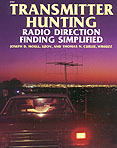 Go to Southern California ARDF -- Current radio-orienteering news and results
Go to Southern California ARDF -- Current radio-orienteering news and results
Go to International-Style Foxhunting Comes To The Americas -- How we're getting the ball rolling
Go to Equipment Ideas for Radio-Orienteering -- Simple and inexpensive receiving and transmitting solutions
Go to Foxhunting for Scouts -- Let's get the kids involved
Go to Local ARDF Contacts -- Links to hams and groups that are doing international-style foxhunting in North America and around the world.
 Back to the Homing In home page
Back to the Homing In home page
This page updated 13 May 2007